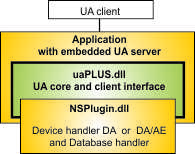|
The uaPLUS generic server is also provided as a DLL for users that want to embed the UA server into an application. The user application needs to reference the uaPLUSdll.Net4.dll
The embedded uaPLUS server uses handler DLLs in the same way as described for the Stand-alone UA Server
The main application can reference the handler DLLs and access the handler instances thru properties in the uaPLUS class (see below). Sample VS solutions for embedded UA servers are provided: |
 |
The server main application can access properties in the uaPLUS DLL.
Static Properties in the class uaPLUS
These properties can be set before the UA server instance is created.
//
The name of the server manufacturer returned in the server status.public static string ManufacturerName = "Advosol Inc.";
//
The name of the server product name returned in the server status.public static string ProductName = "uaPLUS Server";
// The name of the root node for DA node structure
// If null at server startup then the value is set from the configuration file AppSettings definition "daRootName", if found.
/// If the name is defined as disable then DA functionality is not started even if handlers are available.
public static string daRootName = null;
//
The name of the root node with the Historian node structure.// Set the name equal to the daRootName if HDA is implemented in NSPlugin.dll.
// In this case each node can have DA and HDA access rights.
// If null at server startup then the value is set from the configuration file AppSettings definition "hdaRootName", if found.
/// If the name is defined as disable then HDA functionality is not started even if handlers are available.
public static string hdaRootName = null;
//
The name of the root node for AE area/sources node structure// If null at server startup then the value is set from the configuration file AppSettings definition "aeRootName", if found.
/// If the name is defined as disable then AE functionality is not started even if handlers are available.
public static string aeRootName = null; // When null or set to TRUE the internal HDA base code is used.
// Otherwise the HDA base code has to be provided either within NSPlugin.dll or in the HDAPlugin.dll
// If null at server startup then the value is set from the AppSettings definition "useInternalHDAbase", if found.
public static bool? useInternalHDAbase = null;
Properties in the uaPLUS Class Instance
These properties can be read to get access to the HDA handler DLLs.
//Get the instance of the NSPlugin.dll handler for DA functionality
public AppPlugin daPlugin //Get the instance of the NSPlugin.dll handler for AE functionality
public AppPlugin aePlugin
//Get the instance of the HDAPluginDBA.dll database handler used by the internal HDA base.
//Is null unless HDA is configured for the HDAPluginDBA.dll and the DLL was found.
public HDAPluginDBA.DBAPlugin hdaDBAPlugin //Get the instance of the HDAPlugin.dll handler for HDA functionality
// Is null unless HDA is configured for the external HDA base HDAPlugin.dll and the DLL was found.
public HDAPlugin.AppPlugin hdaBasePlugin
//Get the instance of the HDA base handler in NSPlugin.dll
//Is null unless HDA is configured for the HDA base code in NSPlugin.dll and the classes were found.
public HDAPluginDA.AppPluginHDA hdaBaseInDA //Get the instance of the database access handler in NSPlugin.dll
//Is null unless HDA is configured for the HDA database access code in NSPlugin.dll and the classes were found.
public HDAPluginDADBA.DBAPlugin hdaDBAinDA





